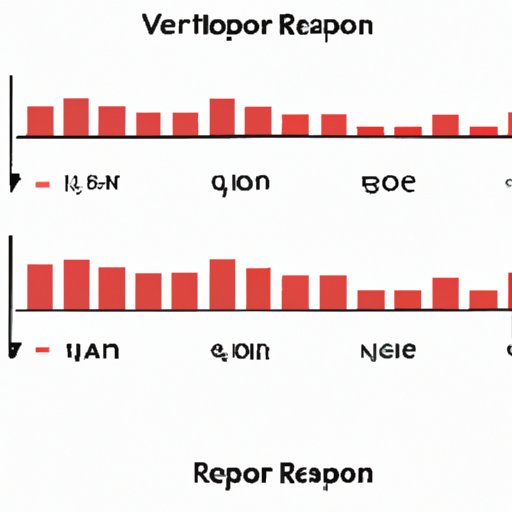Introduction
When analyzing data in scientific research, precision is key. Error bars, also known as uncertainty bars, provide critical information about the variability of a dataset and the accuracy of its measurements. Understanding how to calculate error bars is essential for any researcher hoping to draw meaningful and reliable conclusions from their data. In this article, we’ll explore the types of error bars, formulas for calculating them, and tips for interpreting and using them in practice.
A Comprehensive Guide on How to Calculate Error Bars for Accurate Data Interpretation
Error bars represent the variability and uncertainty in a dataset. They provide information about the spread and distribution of measurements, as well as the precision and accuracy of the data. There are three common types of error bars: standard deviation, standard error, and confidence intervals.
Standard deviation (SD) is a measure of the spread of a dataset, calculated by finding the square root of the variance. It reflects the extent to which individual measurements deviate from the mean. Standard error (SE) is an estimate of the precision of the sample mean, based on the standard deviation of the sample and the sample size. Confidence intervals (CI) express the range of values within which the true population parameter is expected to fall, with a certain level of probability (usually 95%).
To calculate the standard deviation, use the following formula:
Where y is the value of the observation, ̄y is the mean of the sample, and n is the sample size.
To calculate the standard error, use this formula:
Where s is the standard deviation of the sample, and n is the sample size.
Confidence intervals can be calculated using the formula:
Where ȳ is the sample mean, s is the standard deviation, n is the sample size, and t is the t-value from the t-distribution with n-1 degrees of freedom and the desired level of confidence.
It’s important to note that different types of error bars can affect data interpretation differently. For example, in a dataset with a small sample size, using confidence intervals will provide a more accurate estimate of the true population parameters. In contrast, using standard error may be more appropriate for large sample sizes. When calculating error bars, it’s essential to consider the characteristics of the dataset and the research question.
5 Simple Steps for Accurately Calculating Error Bars in Your Scientific Data
Calculating error bars may seem complex, but it can be simplified into five steps:
1. Determine the type of error bar you need (standard deviation, standard error, or confidence intervals).
2. Calculate the mean, standard deviation, and sample size of the dataset.
3. Use the appropriate formula to calculate the error bar.
4. Plot the error bar on your graph or chart.
5. Interpret the error bar in the context of your research question.
Before calculating error bars, it’s essential to ensure that the dataset meets certain assumptions, such as normal distribution. If the data is not normally distributed, alternative methods may be required (such as non-parametric methods).
Mastering Error Bars: Tips and Tricks for Precise Data Analysis
To ensure accurate and precise data analysis using error bars:
– Check for outliers and anomalies in the dataset that may affect the accuracy of the measures.
– Avoid common mistakes, such as confusing standard deviation and standard error, or mixing data scales.
– Interpret the error bars in conjunction with other statistical measures, such as p-values and effect sizes.
– Use error bars to identify trends or patterns in the data, rather than relying solely on individual data points.
– Consider using more advanced methods for calculating error bars, such as Bayesian methods, when appropriate.
By combining error bars with other statistical measures, researchers can gain a more comprehensive understanding of their data and draw more reliable conclusions.
The Importance of Error Bars and How to Calculate Them Effectively
Error bars are crucial for accurate and reliable data analysis in scientific research. Incorrect or misleading error bars can lead to flawed conclusions and hinder scientific progress. By understanding the different types of error bars and how to calculate them effectively, researchers can ensure that their data is precise, accurate and can withstand scrutiny.
When presenting research findings, error bars should always be included as they provide critical information about the variability and uncertainty in the data. By mastering the calculation and interpretation of error bars, researchers can strengthen their analysis and contribute to the advancement of knowledge in their field.
Step-by-Step Tutorial on How to Calculate Error Bars for Your Research Findings
Calculating error bars may vary depending on the specific context and type of analysis. However, by following the general steps outlined earlier (determining the type of error bar, calculating the mean, standard deviation, and sample size, etc.), researchers can apply the appropriate formula to their data and interpret the results in the context of their research question.
For example, when analyzing the effect of a treatment on blood pressure, researchers may use confidence intervals to estimate the range of potential treatment effects, and standard error to estimate the precision of the sample mean. By plotting the error bars in a graph or chart and comparing them to the control group, researchers can draw meaningful conclusions about the effect of the treatment.
Conclusion
In scientific research, precision and accuracy are essential for drawing meaningful and reliable conclusions. By understanding how to calculate and interpret error bars, researchers can ensure that their data is accurate, precise, and can withstand scrutiny. Whether using standard deviation, standard error, or confidence intervals, error bars provide critical information about the variability and uncertainty in the data. By mastering the calculation and interpretation of error bars, researchers can contribute to the advancement of knowledge in their field and make more confident and reliable conclusions about their research findings.
